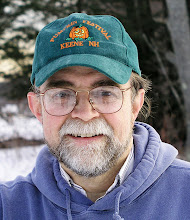 |
| Porcupine Falls |
 |
| Forty Foot Falls Cascade, Surry, NH |
I
like to think that I know all the significant waterfalls around the Monadnock
region, and so it is simultaneously exciting and annoying when I, for the first
time, hear about a nearby display of falling water. The number of dramatic
waterfalls within my corner of New Hampshire is remarkable. I have several
articles about some of the most beautiful, as well as more general reviews of
many others within Cheshire and Hillsborough Counties.
- Waterfalls of Cheshire County
- Chesterfield Gorge Album
- Waterfall Treasures of Hillsborough County
- Photographing the Magic of Velvet Water
 As
always, this is the prime waterfall season with snow melt and spring rains
swelling even the most minor streams. I have been out shooting some of my
favorites, but then friend and photographer Dan Most Facebook posted an image
of Porcupine Falls. Porcupine
Falls?? Why had I never heard of that spot?
As
always, this is the prime waterfall season with snow melt and spring rains
swelling even the most minor streams. I have been out shooting some of my
favorites, but then friend and photographer Dan Most Facebook posted an image
of Porcupine Falls. Porcupine
Falls?? Why had I never heard of that spot?
After
I got over the annoyance, I became excited that there are still new falls to
explore. A quick Google search gave me all the information I needed.
I discovered that Porcupine Falls is a feature of the Calhoun Family
Forest in Gilsum New Hampshire.
Calhoun
Family Forest
 The
355 acre forest preserve had been managed for half a century by John and
Rosemarie Calhoun and, to protect this important resource, the Calhoun family
has donated the land to the Monadnock Conservancy. The forest is located
at the end of White Brook Road which exits Route 10 near the big stone arch
bridge across the Ashuelot River in Gilsum.
The
355 acre forest preserve had been managed for half a century by John and
Rosemarie Calhoun and, to protect this important resource, the Calhoun family
has donated the land to the Monadnock Conservancy. The forest is located
at the end of White Brook Road which exits Route 10 near the big stone arch
bridge across the Ashuelot River in Gilsum.
From a small parking area,
the White Brook Trail follows the brook to Porcupine Falls. It is an easy
0.4 mile stroll. The trail is nicely maintained with sturdy bridges,
walk-ways and a lovely set of stone steps.
Chute and Cascades
 |
| The Chute |
The
falls is most notable for a chute of water that blasts from an elevated rock
formation. The chute was interesting, but I found it difficult to capture
a dramatic composition. To me, the many
cascades, below the falls, were more interesting, especially given the strong
seasonal flow. I suspect that during the
dry seasons these rivulets are less impressive, but I spent much of my time
trying to find angles which incorporated both the main chute and some of these vigorous
cascades.
It
is great to discover a dramatic waterfall, but what I enjoy most is the “working
of the location” to find as many visual angles as possible.
The Swimming Hole?
 One of the best of these didn’t include the
surging chute, but was from below the bridge which spans the brook, just below
the falls. This was also the most
perilous location, as I worked my way into the middle of the stream to get a
clear view of the bridge from across what I suspect, in the summer, will be a
lovely swimming hole. Slow careful
movements are always important when negotiating the slippery rocks around waterfalls
and streams. This is particularly
important when you are alone. I was at the end of a lonely trail, in the fading
light. An incapacitating injury, including a crushed cell phone, could have led
to a long cold night.
One of the best of these didn’t include the
surging chute, but was from below the bridge which spans the brook, just below
the falls. This was also the most
perilous location, as I worked my way into the middle of the stream to get a
clear view of the bridge from across what I suspect, in the summer, will be a
lovely swimming hole. Slow careful
movements are always important when negotiating the slippery rocks around waterfalls
and streams. This is particularly
important when you are alone. I was at the end of a lonely trail, in the fading
light. An incapacitating injury, including a crushed cell phone, could have led
to a long cold night. 
 I
slid my way to a rock that was far too tiny for my substantial butt. Keeping myself dry was only a minor consideration. My primary goal was to avoid dunking my
camera and cable release. Painful experience has taught me that I can dry my
body without long term damage, but my gear is another, expensive, story. I got some great shots and then the more challenging
task was to make it back to the shore.
I
slid my way to a rock that was far too tiny for my substantial butt. Keeping myself dry was only a minor consideration. My primary goal was to avoid dunking my
camera and cable release. Painful experience has taught me that I can dry my
body without long term damage, but my gear is another, expensive, story. I got some great shots and then the more challenging
task was to make it back to the shore.
It
was a lovely and fruitful little hike up the White Brook to Porcupine Falls. I will be back often. It might be worth a trip with my up-coming
Spring Waterfall Workshop. Thanks for
the tip Dan. I forgive you for finding
it first.
Jeffrey Newcomer












